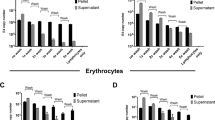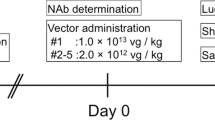Abstract
Recombinant adenoviruses are presently the most efficient in vivo gene transfer system available. Targeting single organs or large tumors by adenoviral vectors requires an intravascular route of application. During the first pass of viral particles through the vascular bed of the target tissue, virus uptake is not quantitative and undefinite amounts of particles leak into circulation. To determine the amount of leaking particles and to calculate organ-specific uptake (in-/outflow ratio), it is necessary to titrate virus particles directly in blood. In preclinical and clinical trials titration is currently mostly done with blood plasma instead of full blood. However, this technique provides valid results only as long as there is no affinity between adenovirus particles and erythrocytes. In this study we demonstrate that Ad5 particles, as mostly employed for gene therapy, have a strong affinity to human erythrocytes. At 60 min after coincubation of human erythrocytes and Ad5 particles, more than 98% of the particles are attached to the surface of erythrocytes. Therefore, ignoring the amount of red cell bound particles by performing titration in plasma leads to severe miscalculation of organ-specific transfer rates or virus circulation half-life. The biological impact of an increased affinity between virus particles and erythrocytes will be discussed.
This is a preview of subscription content, access via your institution
Access options
Subscribe to this journal
Receive 12 print issues and online access
$259.00 per year
only $21.58 per issue
Buy this article
- Purchase on Springer Link
- Instant access to full article PDF
Prices may be subject to local taxes which are calculated during checkout





Similar content being viewed by others
References
Graham FL . Adenovirus vectors for high-efficiency gene transfer into mammalian cells. Immunol Today 2000; 21: 426–428.
Batshaw ML et al. Recombinant adenovirus gene transfer in adults with partial ornithine transcarbamylase deficiency (OTCD). Hum Gene Ther 1999; 10: 2419–2437.
Grines CL et al. Angiogenic Gene Therapy (AGENT) trial in patients with stable agina pectoris. Circulation 2002; 5: 1291–1297.
Cichon G et al. Intravenous administration of recombinant adenoviruses causes thrombocytopenia, anemia and erythroblastosis in rabbits. J Gene Med 1999; 1: 360–371.
Hiltunen MO et al. Biodistribution of adenoviral vector to nontarget tissues after local in vivo gene transfer to arterial wall using intravascular and periadventitial gene delivery methods. FASEB J 2000; 14: 2230–2236.
Chirmule N et al. Immune responses to adenovirus and adeno-associated virus in humans. Gene Ther 1999; 6: 1574–1583.
Rosen L . Hemagglutination by adenoviruses. Virology 1958; 5: 574–577.
Havenga MJE et al. Exploiting the natural diversity in adenovirus tropism for therapy and prevention of disease. J Virol 2002; 76: 4612–4620.
Baum SG . Adenoviridae. In: Mandel GL, Douglas RG, Bennet JD, (eds). Principles and Practice of Infectious Diseases, 2nd edn. John Wiley and Sons: New York, 1984; pp 1353–1361.
Eiz B, Adrian T, Pring Akerblom P . Recombinant fibre proteins of human adenoviruses Ad9, Ad15 and Ad19: localization of the haemagglutination properties and the type-specific determinant. Res Virol 1997; 148: 5–10.
Pring Akerblom P, Heim A, Trijssenaar FE . Molecular characterization of hemagglutination domains on the fibers of subgenus D adenoviruses. J Virol 1988; 72: 2297–2304.
Akalu A, Seidel W, Liebermann H, Bauer U, Dohner L . Rapid identification of subgenera of human adenovirus by serological and PCR assays. J Virol Methods 1998; 71: 187–196.
Krasnykh VN, Mikheeva GV, Douglas JT, Curiel DT . Generation of recombinant adenovirus vectors with modified fibers for altering viral tropism. J Virol 1996; 70: 6839–6846.
McGrory WJD, Bautista S, Graham FL . A simple technique for the rescue of early region I mutations into infectious human adenovirus type 5. Virology 1988; 163: 614–617.
Mittereder N, March KL, Trapnell BC . Evaluation of the concentration and bioactivity of adenovirus vectors for gene therapy. J Virol 1996; 70: 7498–7509.
Morrissey RE et al. Porcine toxicology studies of SCH 58500, a, adenoviral vector for the p53 gene. Toxicol Sci 2002; 65: 256–265.
Morrissey RE et al. Rodent nonclinical safety evaluation od SCH 58500 an adenoviral vector for the p53 gene. Toxicol Sci 2002; 65: 266–275.
Raper SE et al. A pilot study of in vivo liver directed gene transfer with an adenoviral vector in partial ornithine transcarbamylase deficiency. Hum Gene Ther 2002; 13: 163–175.
Acknowledgements
This study was supported by the Bundesministerium fur Bildung und Forschung. We thank Kordelia Hummel and Jenny Schlesinger for their excellent technical assistance. We are grateful to the blood donors among our colleagues and Dr Schulze from the blood bank of the Helios-Klinik of the Charité in Berlin Buch for providing additional blood samples. We thank Dr Meißler for providing blood of domestic pigs. We are very grateful to Andrew Byrnes and Charles Coutelle for important suggestions.
Author information
Authors and Affiliations
Rights and permissions
About this article
Cite this article
Cichon, G., Boeckh-Herwig, S., Kuemin, D. et al. Titer determination of Ad5 in blood: a cautionary note. Gene Ther 10, 1012–1017 (2003). https://doi.org/10.1038/sj.gt.3301961
Received:
Accepted:
Published:
Issue Date:
DOI: https://doi.org/10.1038/sj.gt.3301961
Keywords
This article is cited by
-
Ad5/3 is able to avoid neutralization by binding to erythrocytes and lymphocytes
Cancer Gene Therapy (2021)
-
Barriers to systemic application of virus-based vectors in gene therapy: lessons from adenovirus type 5
Virus Genes (2017)
-
Adenovirus coxsackie adenovirus receptor-mediated binding to human erythrocytes does not preclude systemic transduction
Cancer Gene Therapy (2016)
-
Role of cell surface molecules and autologous ascitic fluid in determining efficiency of adenoviral transduction of ovarian cancer cells
Cancer Gene Therapy (2010)
-
Adenovirus Toxicity and Tropism In Vivo: Not as Simple as A,B,C (or D,E,F)
Molecular Therapy (2007)



